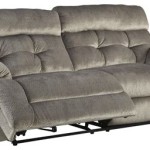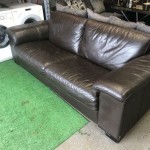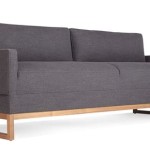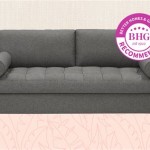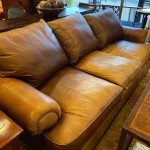Leather and Wood Sofa Bed: Style, Functionality, and Durability
The leather and wood sofa bed represents a fusion of classic aesthetics and modern practicality. This versatile furniture piece offers a comfortable seating solution during the day and transforms into a sleeping surface at night, making it a valuable addition to homes where space is at a premium or where accommodating guests is a regular occurrence. Its appeal lies in the inherent qualities of its constituent materials: the luxurious texture and enduring nature of leather coupled with the natural warmth and structural integrity of wood. Choosing a leather and wood sofa bed involves careful consideration of factors like design, size, mechanism, and the specific types of leather and wood used.
The combination of leather and wood contributes to a design aesthetic that is both timeless and adaptable. The rich texture of leather, available in a wide range of colors and finishes, can complement diverse interior styles, from traditional to contemporary. The presence of wood, whether used for the frame, legs, or decorative accents, adds a touch of organic warmth and sophistication. The visual impact varies based on the style of the sofa bed. Sleek, minimalist designs often feature clean lines and dark leather contrasted with light-toned wood, while more traditional designs may incorporate carved wood detailing and button-tufted leather upholstery.
Beyond aesthetics, the choice of materials significantly impacts the comfort and longevity of the sofa bed. Leather, when properly cared for, is highly durable and resistant to wear and tear. Its natural elasticity provides a comfortable seating surface that conforms to the body over time. Wood, particularly hardwoods like oak, maple, or walnut, offers a robust and stable frame that can withstand frequent use. The construction quality, including the joinery techniques used for the wood frame and the stitching quality of the leather upholstery, plays a pivotal role in the overall lifespan of the furniture.
Understanding the Construction and Mechanisms
The functionality of a sofa bed hinges on its internal mechanism, which facilitates the transition from sofa to bed and vice versa. Several types of mechanisms are commonly used in leather and wood sofa beds, each offering its own advantages and disadvantages. The most common types include pull-out, click-clack, and futon mechanisms.
Pull-out sofa beds feature a hidden mattress that is stored within the sofa frame and can be pulled out when needed. These mechanisms typically involve a metal frame and a foldable mattress. The quality of the metal frame is crucial for ensuring smooth and reliable operation. The mattress can range from thin foam to thicker innerspring or memory foam options. Innerspring mattresses generally provide better support and durability compared to foam mattresses, while memory foam offers enhanced comfort by conforming to the body's contours.
Click-clack sofa beds offer a simpler conversion mechanism. The backrest is designed to fold down flat, creating a sleeping surface. The term "click-clack" refers to the sound the mechanism makes as it locks into different positions. These sofa beds are often more compact than pull-out models and are suitable for smaller spaces. However, the sleeping surface can sometimes be less comfortable due to the potential for a noticeable gap between the seat and backrest sections.
Futon-style sofa beds typically consist of a wooden or metal frame and a thick padded mattress that serves as both the seating and sleeping surface. The frame is designed to fold or recline, allowing the mattress to be positioned as a sofa or a bed. While futons can be a cost-effective option, the comfort level largely depends on the quality and thickness of the mattress.
The choice of mechanism should be based on several factors, including the available space, the frequency of use as a bed, and the desired level of comfort. It's important to test the mechanism thoroughly before purchasing a sofa bed to ensure that it operates smoothly and reliably.
Selecting the Right Leather Type
Leather is a natural material derived from animal hides, primarily cattle. The tanning process transforms raw hides into durable and aesthetically pleasing upholstery. Different types of leather offer varying levels of quality, durability, and price. Understanding the different types of leather is essential for making an informed decision when purchasing a leather sofa bed.
Full-grain leather is considered the highest quality type of leather. It is made from the outermost layer of the hide and retains all of its natural grain markings and imperfections. Full-grain leather is known for its exceptional durability and develops a rich patina over time, enhancing its aesthetic appeal. It is also the most expensive type of leather due to its superior quality and limited availability.
Top-grain leather is the second-highest quality type of leather. It is made from the same layer of the hide as full-grain leather but undergoes a process called "buffing" or "sanding" to remove imperfections and create a more uniform surface. While top-grain leather is still durable and attractive, it lacks the natural character and patina-developing properties of full-grain leather. It is typically less expensive than full-grain leather.
Split-grain leather is made from the lower layers of the hide, which are separated from the top layer. Split-grain leather is less durable and more prone to stretching and tearing than full-grain or top-grain leather. It is often used to create suede or corrected leather, which is embossed with an artificial grain pattern to mimic the appearance of higher-quality leather.
Bonded leather is the lowest quality type of leather. It is made from scraps of leather that are shredded and bonded together with adhesives. Bonded leather is significantly less durable than other types of leather and is prone to cracking and peeling. It is the least expensive type of leather and is often used in budget-friendly furniture.
When choosing a leather sofa bed, it is important to consider the type of leather used in the upholstery. Full-grain or top-grain leather will provide the best combination of durability, comfort, and aesthetic appeal. While split-grain or bonded leather may be more affordable, they are not as durable and may not withstand frequent use.
Choosing the Right Wood and its Finish
The wood used in the frame and accents of a leather and wood sofa bed contributes not only to its structural integrity but also to its overall aesthetic. The type of wood, its finish, and the construction techniques employed all affect the sofa bed's durability, stability, and visual appeal. Selecting the right wood involves considering factors such as hardness, grain pattern, color, and cost.
Hardwoods, such as oak, maple, walnut, and cherry, are generally preferred for furniture construction due to their strength, durability, and resistance to wear. Oak is a popular choice for its durability, distinctive grain pattern, and availability. Maple is a dense hardwood with a smooth grain pattern that is well-suited for staining or painting. Walnut is a premium hardwood known for its rich color, elegant grain pattern, and exceptional strength. Cherry is another popular choice for its warm color, smooth texture, and ability to develop a beautiful patina over time.
Softwoods, such as pine, fir, and cedar, are less dense and less durable than hardwoods. While softwoods are often less expensive, they are not as well-suited for furniture that will be subjected to heavy use. Softwoods are more prone to dents and scratches and may not provide the same level of structural support as hardwoods.
The finish applied to the wood plays a crucial role in protecting it from moisture, scratches, and other environmental factors. Common types of wood finishes include varnish, lacquer, polyurethane, and oil. Varnish provides a durable and water-resistant finish that can be applied in a variety of sheens, from matte to high gloss. Lacquer is a fast-drying finish that provides a smooth and durable surface. Polyurethane is a highly durable finish that is resistant to scratches, stains, and chemicals. Oil finishes penetrate the wood and enhance its natural beauty, but they require regular maintenance to prevent drying and cracking.
The choice of wood and finish should be based on several factors, including the desired aesthetic, the intended use of the sofa bed, and the budget. Hardwoods with durable finishes will provide the best combination of durability, stability, and aesthetic appeal. It's also crucial to inspect the wood for any signs of defects, such as knots, cracks, or warping, before making a purchase.

Urban 84 Sleeper Sofa Poly Fill Weston Leather Gray Cinder West Elm

Leathaire Sofa Bed With Rattan Weaving Wooden Frame

Harris 78 Sleeper Sofa Sierra Leather Black Licorice West Elm

Jasiway 86 6 Brown Modern Style Sofa Bed Leather Loveseat With Square Arm

Queen 3 Seater Leather Sofa Bed 79 Convertible Futon With Side Table Homary

Liville Style Leather European Wooden Sofa Set

Abbey Leather Couch Bed Sofa Beds

82 7 Convertible Bed King Sleeper Sofa Leather Upholstered Storage With Speaker

Matera Leather Three Seats Sofa With Wooden Legs Black

Crafters And Weavers Craftsman Mission 95 Leather Sofa In Light Chestnut

